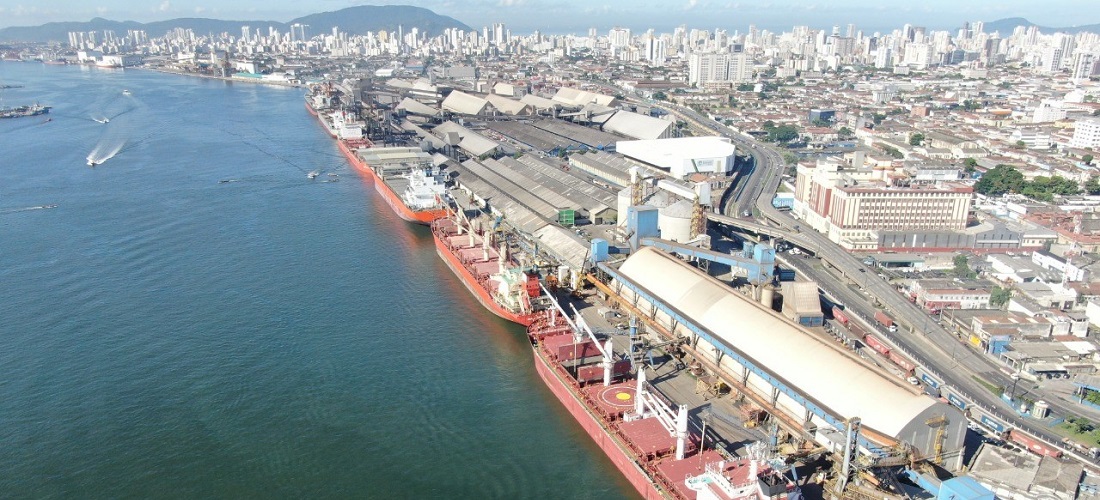
Increase in exports will be a challenge for the Port of Santos
Feb, 13, 2023 Posted by Lillian SmoakWeek 202308
In 2019, the Ministry of Agriculture projected that Brazil would produce 300 million tons of grains in the 2028/29 harvest. This volume, however, should be harvested in this 2022/23 cycle, six years earlier, and the record tends to put pressure on the flow logistics, which has worried agro exporters – soy, corn and also sugar, which “disputes ” space with grains in railroads and port terminals. There are bottlenecks in sight, and costs could rise.
The port of Santos (SP), for example, has a maximum loading capacity of 8 million tons of solid agricultural bulk per month. It turns out that in 2021, this limit was almost reached in March, when 7.5 million tons were exported even with smaller harvests than the current ones. Last year, shipment records were broken in several months.
“We have seen an anticipation of shipments in relation to previous years, and this may put even more pressure on the Brazilian port system this year, in the face of a more voluminous grain harvest,” Thiago Péra, general coordinator of the Research and Extension Group, told Valor. in Agroindustrial Logistics (EsalqLog), from the “Luiz de Queiroz” School of Agriculture (Esalq/USP).
According to a study by EsalqLog, on average a 10% increase in the volume of exports at the port generates a 5% increase in the length of stay of ships in Santos, in addition to increasing the volume of traffic on toll roads to the port by 1%. . “This can generate queues of trucks and increase the price of freight,” said Péra.
Competition with sugar
Although sugar exports are more regular, there is a slight peak in July and August, precisely when the second corn crop will begin to flow – for both products, estimates point to increases in production and exports. “At the beginning of the year, the sugar-energy segment’s off-season prevents sugar shipments from coinciding with soybeans, but the increase in Brazilian corn exports could cause an increase in freight prices in the second half,” noted Péra.
Check below a history of Brazilian corn exports from 2019. The data is from DataLiner:
Brazilian Corn Exports | Jan 2019 – Dec 2022 | WTMT
Source: DataLiner (click here for a demo)
In the first week of February, Paulo Roberto de Souza, CEO of Alvean (trading by Copersucar) said that the segment is concerned with logistics. “Crops are growing and there is a forecast that the supercrop of grains will be harvested with sugar from April onwards,” he said at an XP event in São Paulo. Alvean’s expectation is that the bottleneck will limit the export of sugar by 2.5 million tons per month, while the need would be around 3 million.
This scenario, however, can be avoided because there is room for transporting grains through other logistical corridors, and even Santos is far from the limit of its capacity to transport bulk after the peak transport of soybeans (February and March) and corn ( July and August). On average, Santos has shipped around 5.3 million tons of grain per month.
Arco Norte
Arco Norte ports are transporting, on average, 3.3 million tons per month, and the maximum volume was observed in March 2022 (5.3 million tons). “At Arco Norte, sales are more linear throughout the year, because the Matopiba harvest is later and because sales from the northern region of Mato Grosso are already captive”, stated Péra.
In the case of soybeans, exports from Santos usually reach 73% of the annual total expected, on average for recent years, while in Arco Norte the percentage reaches 53.3%. Corn shipments are more balanced: they reach 72.8% in Arco Norte and 70.5% in Santos in October.
Guaranteed transport
According to the Port Authority of Santos, since 2015 there has been a change in the proportion of solid vegetable bulk exported by the sugar terminals of the organized port, which now include grains in the mix of products handled (49% in 2019).
More recent studies with projections of capacity and demand for solid vegetable bulk in the port of Santos point to volumes of 80 million tons in 2030, compared to an estimated capacity of 104 million, after investments. “Port planning is constant, and the integrated capacity of the port’s terminal subsystems naturally follows the demand increases”, said the administration.
The port of Santos reported that, in order to provide adequate increases in view of the new projected volumes, in March last year, the STS 11 terminal was purchased by Cofco International (Chinese trading company), with forecast investments of R$ 764.8 million which include the construction of new silos and warehouses. In addition to STS 11, part of the port’s vegetable bulk terminals, such as those located in Ponta da Praia and on the left bank, have completed or ongoing works, also for the expansion of grain handling capacity.
“Additionally, due to these investments, and already anticipating the need to dispose of larger volumes, in December 2022 a contract was signed with the new concessionaire that will be responsible for the management, operation, maintenance and expansion of the Internal Railroad of the Port of Santos ( Fips). Under this contract, R$ 891 million in investments are foreseen, which will increase the current rail capacity, from 50 million to 115 million tons/year”, stated the port administration.
Source: Valor Econômico
To read the original report, visit: https://valor.globo.com/agronegocios/noticia/2023/02/13/aumento-das-exportacoes-sera-desafio-para-o-porto-de-santos.ghtml
-
Ports and Terminals
Apr, 13, 2022
0
Port of Paranaguá’s new pulp terminal is nearing completion; the unit is scheduled to begin operations this year
-
Ports and Terminals
Jun, 28, 2021
0
Argentina: unloading structure collapses at the Puerto Quequén terminal
-
Ports and Terminals
May, 26, 2020
0
Infrastructure Ministry devolves power to auction port facililties to São Francisco do Sul Port
-
Oil and Gas
Jul, 17, 2023
0
China to boost Brazil oil imports in Q3, replacing some Saudi supply


